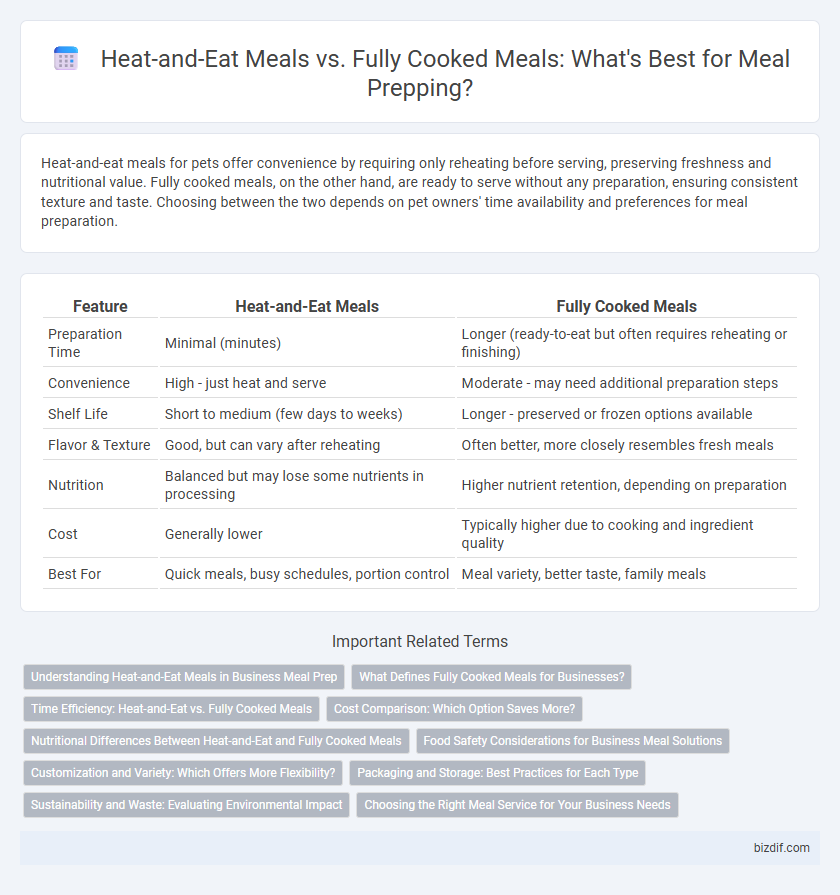Heat-and-eat meals for pets offer convenience by requiring only reheating before serving, preserving freshness and nutritional value. Fully cooked meals, on the other hand, are ready to serve without any preparation, ensuring consistent texture and taste. Choosing between the two depends on pet owners' time availability and preferences for meal preparation.
Table of Comparison
| Feature | Heat-and-Eat Meals | Fully Cooked Meals |
|---|---|---|
| Preparation Time | Minimal (minutes) | Longer (ready-to-eat but often requires reheating or finishing) |
| Convenience | High - just heat and serve | Moderate - may need additional preparation steps |
| Shelf Life | Short to medium (few days to weeks) | Longer - preserved or frozen options available |
| Flavor & Texture | Good, but can vary after reheating | Often better, more closely resembles fresh meals |
| Nutrition | Balanced but may lose some nutrients in processing | Higher nutrient retention, depending on preparation |
| Cost | Generally lower | Typically higher due to cooking and ingredient quality |
| Best For | Quick meals, busy schedules, portion control | Meal variety, better taste, family meals |
Understanding Heat-and-Eat Meals in Business Meal Prep
Heat-and-eat meals in business meal prep offer maximum convenience by requiring minimal preparation time, typically involving pre-cooked ingredients sealed for quick reheating. These meals ensure consistent portion control and nutritional balance, making them ideal for corporate environments prioritizing efficiency and health. Compared to fully cooked meals, heat-and-eat options reduce handling and storage complexities while maintaining freshness through advanced packaging technologies.
What Defines Fully Cooked Meals for Businesses?
Fully cooked meals for businesses are pre-prepared dishes that have undergone complete cooking processes, ensuring they are safe for immediate consumption or require minimal reheating. These meals meet stringent food safety standards, often involving precise temperature controls and packaging designed to preserve freshness and flavor during storage. Compared to heat-and-eat options, fully cooked meals offer convenience without compromising on quality, making them ideal for food service providers seeking efficiency and consistency.
Time Efficiency: Heat-and-Eat vs. Fully Cooked Meals
Heat-and-eat meals offer superior time efficiency by requiring only a few minutes in the microwave, eliminating the need for extensive preparation or cooking. Fully cooked meals often demand reheating and occasional stove-top attention, increasing total meal time. Consumers seeking quick meal solutions typically prefer heat-and-eat options for their convenience and speed.
Cost Comparison: Which Option Saves More?
Heat-and-eat meals generally cost less due to lower packaging and preparation expenses, making them a budget-friendly choice for quick consumption. Fully cooked meals often have higher price points reflecting the labor-intensive cooking process and premium ingredients used. Evaluating the cost per serving reveals heat-and-eat options save more money, especially when purchased in bulk or during promotions.
Nutritional Differences Between Heat-and-Eat and Fully Cooked Meals
Heat-and-eat meals often contain higher levels of preservatives and sodium to extend shelf life, which can impact overall nutritional quality compared to fully cooked meals prepared fresh. Fully cooked meals typically retain more nutrients and have fewer additives, providing a healthier balance of vitamins and minerals. Consumers seeking optimal nutrition should consider the ingredient transparency and processing methods used in each meal type.
Food Safety Considerations for Business Meal Solutions
Heat-and-eat meals require strict temperature control during storage and reheating to prevent bacterial growth, with FDA guidelines recommending reheating to at least 165degF (74degC). Fully cooked meals offer an advantage by reducing the risk of undercooking but still demand proper packaging and handling to maintain food safety standards throughout distribution. Implementing Hazard Analysis Critical Control Points (HACCP) protocols ensures consistent monitoring and minimizes contamination risks in business meal solutions.
Customization and Variety: Which Offers More Flexibility?
Heat-and-eat meals provide limited customization as they are pre-portioned and designed for quick consumption, whereas fully cooked meals offer greater flexibility for adjustments in ingredients, portion sizes, and seasoning to suit individual preferences. Meal prepping with fully cooked meals enables variety by allowing cooks to modify recipes or combine different components throughout the week, enhancing nutritional balance and taste diversity. Customized meal plans leveraging fully cooked options adapt better to dietary restrictions and evolving flavor preferences compared to the standardized heat-and-eat alternatives.
Packaging and Storage: Best Practices for Each Type
Heat-and-eat meals typically require microwave-safe, airtight containers that help maintain freshness and prevent leakage during reheating, making storage efficient with stackable packaging. Fully cooked meals benefit from vacuum-sealed packaging that extends shelf life by reducing oxygen exposure and preserving flavor, ideal for refrigeration or freezing. Proper labeling with dates and reheating instructions ensures food safety and optimizes the meal prepping process for both types.
Sustainability and Waste: Evaluating Environmental Impact
Heat-and-eat meals typically generate less food waste due to portion control and longer shelf life, contributing to reduced environmental impact compared to fully cooked meals that may lead to excessive leftovers. Fully cooked meals often require more energy for reheating and preservation, increasing their carbon footprint relative to heat-and-eat options optimized for efficiency. Sustainable meal prepping prioritizes minimizing packaging waste and selecting ingredients with lower environmental costs to enhance overall sustainability.
Choosing the Right Meal Service for Your Business Needs
Heat-and-eat meals offer quick preparation and convenience, making them ideal for businesses prioritizing speed and minimal kitchen resources. Fully cooked meals provide superior flavor and presentation, suited for establishments focused on quality and customer experience. Evaluating operational capacity, target market preferences, and storage facilities ensures selecting the meal service that optimally supports your business goals.
Heat-and-eat meals vs fully cooked meals Infographic

 bizdif.com
bizdif.com